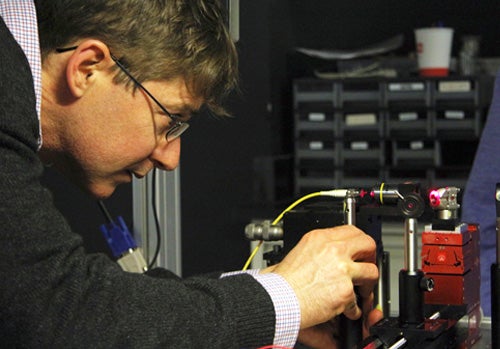
Waterloo invention advances quantum computing research
New device, which will be used in labs around the world to develop quantum technologies, produces fragile entangled photons in a more efficient way

New device, which will be used in labs around the world to develop quantum technologies, produces fragile entangled photons in a more efficient way
By Sabrina Hutchison Office of ResearchCreating entangled photons is part of the work quantum computing researchers perform in their labs. But for the past 30 years, scientists have been slowed down and frustrated by the large, often finicky machines they’ve had to use to generate them.
Now, a University of Waterloo researcher has invented a device - so small it fits into your hand - that can do the job. And far from being a fussy, difficult machine to operate, the Waterloo device can be tossed around the room - and still work.

Rolf Horn, a postdoctoral fellow at Waterloo’s Institute for Quantum Computing (IQC), invented the device that will be brought to market soon so scientists around the world can use it in their labs. This new device advances quantum research by providing a simpler, more efficient way of producing entangled photons.
“This device is inspirational because it will accelerate quantum inventions and commercialization at IQC and around the world,” says Raymond Laflamme, executive director at IQC and mentor to Horn. “We’re at the beginning of an era, for IQC and society as a whole, as we start to see the germination of quantum innovations that are ripe for commercialization. We’re very proud that all of the work to develop this device was done at IQC.”
Thomas Jennewein, an associate professor at IQC who contributed his expertise on entangled photons to the development of the device, said there are hundreds of quantum research groups that could benefit from the invention. “Rolf’s pre-aligned, robust, and significantly smaller device fixes a huge flaw in the process of producing entangled photons for quantum research, which will save months of time and work,” says Jennewein.
The photons produced by the device are also extremely fragile which, in quantum terms, makes them very secure. If someone attempts to measure one photon, the pair of photons becomes uncorrelated and the user can tell there has been interference. This is a considerable improvement to current information security where keys used to protect data, such as passwords, are becoming easier to crack and users don’t know their information is being looked at until it’s too late.
“Nothing is 100 per cent secure but this invention could improve security dramatically from anything that’s available today,” says Horn. “Pictures and other data could be encrypted with keys created by this quantum source. You would then be notified if someone tried to look at these keys, and you could stop sending sensitive information immediately.”
Assisted by the Waterloo Commercialization Office (WatCo), Horn and his team received a Natural Sciences and Engineering Research Council of Canada (NSERC) Idea to Innovation Grant allowing the team to work with industry partners to build the hardware, optimize the device’s system, and prepare the invention for commercialization.

Read more
Lesson 2.5: how jellyfish can change your perspective on R&D

Read more
Leaders tell Waterloo Innovation Summit to fund basic research to commercialize unexpected outcomes

Read more
President Kolinda Grabar-Kitarović will tour the Institute for Quantum Computing
The University of Waterloo acknowledges that much of our work takes place on the traditional territory of the Neutral, Anishinaabeg, and Haudenosaunee peoples. Our main campus is situated on the Haldimand Tract, the land granted to the Six Nations that includes six miles on each side of the Grand River. Our active work toward reconciliation takes place across our campuses through research, learning, teaching, and community building, and is co-ordinated within the Office of Indigenous Relations.